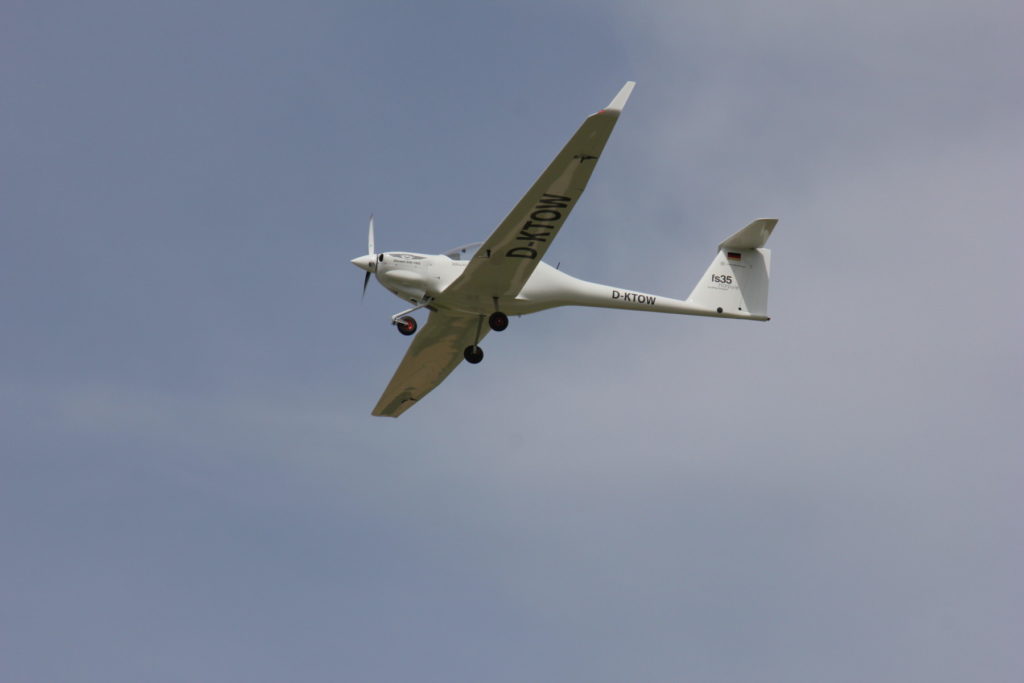
We finally did it! On the 13th of August 2019, our fs35 “Harpyie” finally took to the skies for the first time!
Thus ends a long chapter in our little club. Ever since the idea for the project was born in 2003 and construction began in 2010, over 70 students have worked together alongside their studies to achieve this goal. If there’s one word that can be used to describe us at this moment, it’s proud, for our plane’s in the air.
At 14:37 local time at the airfield in Schwäbisch Hall, the fs35’s wheels left the ground for the first time, the plane’s 18 meter long wings soaring through the sky accompanied by the beat of the 155 hp Continental engine. It’s during moments like these where one looks back at all the parts, hours, calculations, sleepless nights and nerve-wracking tests that all brought us here. It’s quite difficult to believe that it all worked out so well in the end.
We had to wait a long time for the necessary certification papers from the LBA (Federal Aviation Office) after our high-speed taxi tests in May. This delay was unexpected so luckily for us, we didn’t set any deadlines or promises on when the first flight would take place. It was all forgotten, as corny as it sounds, in a shower of hugs and congratulations as the airplane touched down.
The first flight was done by a highly experienced test pilot by the name Ingmar Mayerbuch. Mr. Mayerbuch was the head of the flight test division at Diamond Aircraft and is currently head of such a division at the DLR (German Aerospace Center) Oberpfaffenhofen. With such qualifications, Mr. Mayerbuch was the obvious choice fur such a critical flight.
Even after the relatively short flight, confidence that this peppy little plane of ours will meet our expectations of becoming a trendsetting glider tug. A consequent implementation of an aircraft design optimized for rate of climb allows for the use of a for this type of plane one-of-a kind engine. The turbocharged four-cylinder CD-155 diesel engine from the company Technify will ensure an efficient yet powerful aerotow. The operation and handling of the aircraft is simplified by the ergonomic setup of the cockpit, making it easy and safe to fly.
We would like to thank all our supporters, helpers, friends, and sponsors, whom we would also like to invite to the official christening of the plane. We would especially like to thank those, without whom the whole project would have failed. For most of the structural components, resin from HEXION along with carbon fiber from TEIJIN in association with C. Cramer & Co. and plastic lumber from Gaugler & Lutz oHG and Diab were used. We thank MEXAPLEX for providing us with the canopy and Winter Instruments, Air Avionics, and Dynon Avionics for the cockpit instrumentation. Of course, we would also like to thank Technify of the Continental-Motors Group for the most advanced engines to ever be installed in a motor glider and MT for the propeller. We have Schütze to thank for the lightweight yet sturdy control rods and Tost for the indispensable tow coupling in the tail.
The climb performance is simply phenomenal!
Ingmar Mayerbuch – Pilot of the fs35’s first flight
Around 60 other companies supported us with smaller parts, materials, and tools, becoming an irreplaceable part of the program in the process. Furthermore, we extend our gratitude to workers from Diamond-Aircraft, Schempp-Hirth, Alexander-Schleicher Glider Works, Technify, and many others who guided and advised throughout the realization of this project. Special thanks go to the University of Stuttgart and a multitude of its institutes which provided us with the necessary environment and support for our project, ensuring the continued existence of our club. Finally, we would like to thank all sponsors, motivators, the Idaflieg, and others we haven’t mentioned. Thank you for your support!
Of course, the first flight isn’t the end, rather the beginning of a new chapter. Flight tests, expanded flight tests and full certification are the final goals. A large amount of exciting work and tests that will grant us insights into new fields of aviation await us. We are looking forward to finish these as soon as possible. so that we can show our plane at your airfield.

